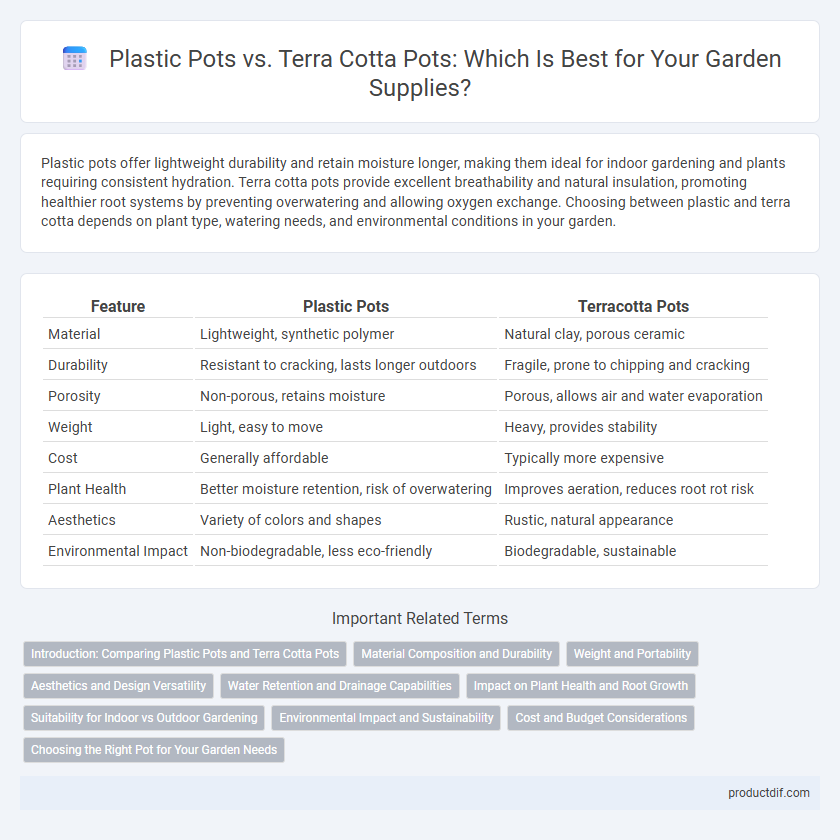Plastic pots offer lightweight durability and retain moisture longer, making them ideal for indoor gardening and plants requiring consistent hydration. Terra cotta pots provide excellent breathability and natural insulation, promoting healthier root systems by preventing overwatering and allowing oxygen exchange. Choosing between plastic and terra cotta depends on plant type, watering needs, and environmental conditions in your garden.
Table of Comparison
| Feature | Plastic Pots | Terracotta Pots |
|---|---|---|
| Material | Lightweight, synthetic polymer | Natural clay, porous ceramic |
| Durability | Resistant to cracking, lasts longer outdoors | Fragile, prone to chipping and cracking |
| Porosity | Non-porous, retains moisture | Porous, allows air and water evaporation |
| Weight | Light, easy to move | Heavy, provides stability |
| Cost | Generally affordable | Typically more expensive |
| Plant Health | Better moisture retention, risk of overwatering | Improves aeration, reduces root rot risk |
| Aesthetics | Variety of colors and shapes | Rustic, natural appearance |
| Environmental Impact | Non-biodegradable, less eco-friendly | Biodegradable, sustainable |
Introduction: Comparing Plastic Pots and Terra Cotta Pots
Plastic pots offer lightweight durability and retain moisture longer, making them ideal for plants requiring consistent hydration. Terra cotta pots, made from porous clay, enhance aeration and prevent overwatering, promoting healthy root systems. Both options cater to different gardening needs based on plant type, watering habits, and environmental conditions.
Material Composition and Durability
Plastic pots, made from various polymers like polypropylene or polyethylene, offer lightweight durability and resistance to cracking or breaking under impact, making them ideal for diverse weather conditions. Terra cotta pots, composed primarily of natural clay fired at high temperatures, provide excellent breathability and moisture regulation but are more fragile and prone to chipping or cracking in extreme cold. The choice between plastic and terra cotta pots depends on balancing material longevity with plant health requirements related to air and water permeability.
Weight and Portability
Plastic pots are significantly lighter than terra cotta pots, making them easier to move and ideal for frequent rearranging or indoor gardening. Terra cotta pots have a heavier weight, providing greater stability in outdoor settings and resistance to being knocked over by wind. The portability advantage of plastic pots benefits gardeners who require flexible plant placement without sacrificing durability.
Aesthetics and Design Versatility
Plastic pots offer a wide range of colors, shapes, and finishes, enhancing design versatility for various garden styles and indoor setups. Terra cotta pots showcase a classic, earthy aesthetic with their natural reddish-brown hue and porous texture, promoting a timeless and rustic garden appearance. While plastic pots allow for customization and modern flair, terra cotta pots provide organic charm and complement traditional or Mediterranean-inspired landscapes.
Water Retention and Drainage Capabilities
Plastic pots offer superior water retention due to their non-porous surfaces, making them ideal for plants requiring consistent moisture levels. Terra cotta pots provide excellent drainage and breathability, allowing excess water to evaporate through their porous walls, which helps prevent root rot in drought-tolerant plants. Choosing between plastic and terra cotta depends on a plant's specific water needs and the grower's watering frequency preferences.
Impact on Plant Health and Root Growth
Plastic pots retain moisture longer, reducing the risk of dehydration but potentially causing root rot if overwatered, while terra cotta pots offer superior aeration and drainage, promoting healthier root systems and preventing fungal growth. Plants in terra cotta pots often develop stronger root structures due to better oxygen exchange and natural evaporation through the porous material. Choosing between plastic and terra cotta pots directly influences plant health by balancing moisture retention and air circulation essential for optimal root development.
Suitability for Indoor vs Outdoor Gardening
Plastic pots offer lightweight durability and excellent moisture retention, making them ideal for indoor gardening where controlled watering is essential. Terra cotta pots, known for their porous nature, provide superior aeration and natural moisture evaporation, which suits outdoor gardening environments by preventing root rot in exposed conditions. Choosing between plastic and terra cotta depends on the plant species and location, with plastic preferred indoors and terra cotta favored for outdoor use.
Environmental Impact and Sustainability
Plastic pots, often made from non-biodegradable materials like polyethylene, contribute significantly to landfill waste and environmental pollution, as they take hundreds of years to decompose. Terra cotta pots, composed of natural clay, are biodegradable and have a lower environmental footprint due to their natural composition and inert firing process. Choosing terra cotta pots supports sustainability through recyclability and reduced plastic waste, making them a more eco-friendly option in garden supply.
Cost and Budget Considerations
Plastic pots are generally more affordable than terra cotta pots, making them a budget-friendly option for large-scale gardening projects. Terra cotta pots tend to be more expensive upfront due to their material and craftsmanship but offer better breathability and aesthetic appeal. When prioritizing cost, plastic pots provide a lightweight, durable, and economical solution for gardeners on a tight budget.
Choosing the Right Pot for Your Garden Needs
Plastic pots offer lightweight durability and retain moisture effectively, making them ideal for plants that require consistent watering. Terra cotta pots provide natural breathability and excellent drainage, benefiting plants prone to root rot or overwatering. Selecting between plastic and terra cotta depends on your garden's watering routine, plant type, and environmental conditions for optimal growth.
Plastic pots vs Terra cotta pots Infographic

 productdif.com
productdif.com